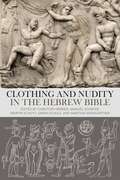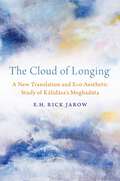- Table View
- List View
The Clergyman's Wife: A romantic new novel to curl up with for fans of Miss Austen
by Molly GreeleyShe married for her future.But then she fell in love . . .Curl up with the beautiful, romantic tale of a woman forced to choose between her duty and her heart. ______________________________ Charlotte Collins is the dutiful wife of Hunsford's vicar. Although it may not be perfect, her marriage allows her security, and so she patiently tolerates Mr Collins' awkward lectures and cares for their young daughter.But there's more to Charlotte than she'd have you think. Fiercely intelligent and pragmatic, Charlotte yearns for something more.When she meets Mr Travis, a local farmer, Charlotte starts to feel a spark of something she has never felt before.Could it be desire? Could it even be love? And will she listen to what her head is telling her or should she follow her heart?Escape into the world of Mr Darcy and Elizabeth Bennet one more time with this charming, poignant story for fans of Miss Austen by Gill Hornby and Longbourn by Jo Baker._____________________________WHAT PEOPLE ARE SAYING'Excellent...the well-crafted prose captures perfectly the relationship dynamics and the time period. I honestly cannot say enough to praise the quality of The Clergyman's Wife. If you enjoy subtle historical "slice of life" novels, then you really need to read this one!' Amazon Reviewer'Molly Greeley manages to tell Charlotte's story in a refreshingly contemporary style while at the same time keeping the reader's feet firmly planted in a time gone by' Shannon Winslow, author of The Darcys of Pemberley'A total pleasure to read! Greeley has captured Austen's tone and has updated her style a bit to write a terrific read not only for Austen fans but for others as well' Amazon Reviewer'Ideal for fans of Austen's work, Greeley's strong debut also stands on its own' Publishers Weekly'There is nothing better than a book that makes you want to stop time! I truly felt taken away...Taken away in the beautiful use of language, and a truly magnificent storyline. You'll need some time to spend frolicking with Charlotte and her family and friends through her days, because you won't want to put the book down' Amazon Reviewer
Clerical Households in Late Medieval Italy (I Tatti studies in Italian Renaissance history #20)
by Roisin CossarRoisin Cossar examines how clerics managed efforts to reform their domestic lives in the decades after the Black Death. Despite reformers’ desire for clerics to remain celibate, clerical households resembled those of the laity, and priests’ lives included apprenticeships in youth, fatherhood in middle age, and reliance on their families in old age.
Clerical Households in Late Medieval Italy (I Tatti studies in Italian Renaissance history #20)
by Roisin CossarRoisin Cossar examines how clerics managed efforts to reform their domestic lives in the decades after the Black Death. Despite reformers’ desire for clerics to remain celibate, clerical households resembled those of the laity, and priests’ lives included apprenticeships in youth, fatherhood in middle age, and reliance on their families in old age.
Clerical Sexual Abuse: How the Crisis Changed US Catholic Church-State Relations (Palgrave Studies in Religion, Politics, and Policy)
by Jo Renee FormicolaThe book discusses the changing relationship between American Catholic Bishops and civil authorities in the United States, as civil authority has eclipsed traditional Catholic ecclesiastical privilege and clerical exemption resulting from the hierarchical mismanagement and cover-up of clerical sexual abuse in the United States.
Clerical Vestments: Ceremonial Dress of the Church (Shire Library)
by Sarah BaileyThe churches of Britain contain a remarkable heritage of exquisitely embroidered vestments, and cathedrals in particular hold some of the most beautiful textiles ever produced in Europe. The history of these priestly garments and how their use developed in Britain and Europe is fascinating. This book outlines the tradition and mysticism associated with them and the role they still play in the 'theatre' of church, and shows how colour and ornament are used in the symbolism of the Christian faith. It explores the history of vestment production up to the present day, covering the practicalities of design, the sourcing of fabrics and the embroiderers themselves.
Clerical Vestments: Ceremonial Dress of the Church (Shire Library #727)
by Sarah BaileyThe churches of Britain contain a remarkable heritage of exquisitely embroidered vestments, and cathedrals in particular hold some of the most beautiful textiles ever produced in Europe. The history of these priestly garments and how their use developed in Britain and Europe is fascinating. This book outlines the tradition and mysticism associated with them and the role they still play in the 'theatre' of church, and shows how colour and ornament are used in the symbolism of the Christian faith. It explores the history of vestment production up to the present day, covering the practicalities of design, the sourcing of fabrics and the embroiderers themselves.
The Clerics of Islam: Religious Authority and Political Power in Saudi Arabia
by Nabil MoulineFollowers of Muhammad b. ’Abd al-Wahhab, often considered to be Islam’s Martin Luther, shaped the political and religious identity of the Saudi state while also enabling the significant worldwide expansion of Salafist Islam. Studies of the movement he inspired, however, have often been limited by scholars’ insufficient access to key sources within Saudi Arabia. Nabil Mouline was granted rare interviews and admittance to important Saudi archives in preparation for this groundbreaking book, the first in-depth study of the Wahhabi religious movement from its founding to the modern day. Gleaning information from both written and oral sources and employing a multidisciplinary approach that combines history, sociology, and Islamic studies, Mouline presents a new reading of this movement that transcends the usual resort to polemics.
Climate, Catastrophe, and Faith: How Changes in Climate Drive Religious Upheaval
by Philip JenkinsOne of the world's leading scholars of religious trends shows how climate change has driven dramatic religious upheavals. Long before the current era of man-made climate change, the world has suffered repeated, severe climate-driven shocks. These shocks have resulted in famine, disease, violence, social upheaval, and mass migration. But these shocks were also religious events. Dramatic shifts in climate have often been understood in religious terms by the people who experienced them. They were described in the language of apocalypse, millennium, and Judgment. Often, too, the eras in which these shocks occurred have been marked by far-reaching changes in the nature of religion and spirituality. Those changes have varied widely--from growing religious fervor and commitment; to the stirring of mystical and apocalyptic expectations; to waves of religious scapegoating and persecution; or the spawning of new religious movements and revivals. In many cases, such responses have had lasting impacts, fundamentally reshaping particular religious traditions. In Climate, Catastrophe, and Faith historian Philip Jenkins draws out the complex relationship between religion and climate change. He asserts that the religious movements and ideas that emerge from climate shocks often last for many decades, and even become a familiar part of the religious landscape, even though their origins in particular moments of crisis may be increasingly consigned to remote memory. By stirring conflicts and provoking persecutions that defined themselves in religious terms, changes in climate have redrawn the world's religious maps, and created the global concentrations of believers as we know them today. This bold new argument will change the way we think about the history of religion, regardless of tradition. And it will demonstrate how our growing climate crisis will likely have a comparable religious impact across the Global South.
Climate, Catastrophe, and Faith: How Changes in Climate Drive Religious Upheaval
by Philip JenkinsOne of the world's leading scholars of religious trends shows how climate change has driven dramatic religious upheavals. Long before the current era of man-made climate change, the world has suffered repeated, severe climate-driven shocks. These shocks have resulted in famine, disease, violence, social upheaval, and mass migration. But these shocks were also religious events. Dramatic shifts in climate have often been understood in religious terms by the people who experienced them. They were described in the language of apocalypse, millennium, and Judgment. Often, too, the eras in which these shocks occurred have been marked by far-reaching changes in the nature of religion and spirituality. Those changes have varied widely--from growing religious fervor and commitment; to the stirring of mystical and apocalyptic expectations; to waves of religious scapegoating and persecution; or the spawning of new religious movements and revivals. In many cases, such responses have had lasting impacts, fundamentally reshaping particular religious traditions. In Climate, Catastrophe, and Faith historian Philip Jenkins draws out the complex relationship between religion and climate change. He asserts that the religious movements and ideas that emerge from climate shocks often last for many decades, and even become a familiar part of the religious landscape, even though their origins in particular moments of crisis may be increasingly consigned to remote memory. By stirring conflicts and provoking persecutions that defined themselves in religious terms, changes in climate have redrawn the world's religious maps, and created the global concentrations of believers as we know them today. This bold new argument will change the way we think about the history of religion, regardless of tradition. And it will demonstrate how our growing climate crisis will likely have a comparable religious impact across the Global South.
Climate Change and the Symbol Deficit in the Christian Tradition: Expanding Gendered Sources (T&T Clark Explorations in Theology, Gender and Ecology)
by Jan-Olav HenriksenExploring how the climate crisis discloses the symbol deficit in the Christian tradition, this book argues that Christianity is rich in symbols that identify and address the failures of humans and the obstacles that prevent humans from doing well, while positive symbols that can engage people in constructive action seem underdeveloped. Henriksen examines the potential of the Christian tradition to develop symbols that can engage peoples in committed and sustained action to prevent further crisis. To do so, he argues that we need symbols that engage both intellectually and emotionally, and which enhance our perception of belonging in relationships with other humans, be it both in the present and in the future. According to Henriksen, the deficit can only be obliterated if we can develop symbols that have some root or resonance in the Christian tradition, provide concrete and specified guidance of agency, engage people both emotionally and intellectually, and finally open up to visions for a moral agency that provide positive motivations for caring about environmental conditions as a whole.
Climate Change and the Symbol Deficit in the Christian Tradition: Expanding Gendered Sources (T&T Clark Explorations in Theology, Gender and Ecology)
by Jan-Olav HenriksenExploring how the climate crisis discloses the symbol deficit in the Christian tradition, this book argues that Christianity is rich in symbols that identify and address the failures of humans and the obstacles that prevent humans from doing well, while positive symbols that can engage people in constructive action seem underdeveloped. Henriksen examines the potential of the Christian tradition to develop symbols that can engage peoples in committed and sustained action to prevent further crisis. To do so, he argues that we need symbols that engage both intellectually and emotionally, and which enhance our perception of belonging in relationships with other humans, be it both in the present and in the future. According to Henriksen, the deficit can only be obliterated if we can develop symbols that have some root or resonance in the Christian tradition, provide concrete and specified guidance of agency, engage people both emotionally and intellectually, and finally open up to visions for a moral agency that provide positive motivations for caring about environmental conditions as a whole.
Climax of Prophecy: Studies on the Book of Revelation
by Richard BauckhamThe Apocalypse of John is a work of immense importance and learning. Yet among the major works of early Christianity included in the New Testament it has received relatively little scholarly attention.This work is a significant contribution to remedying this neglect. The author examines the meticulous literary artistry, creative imagination, radical political critique and profound theology of the Apocalypse of John. It is a sustained enterprise to understand both the form and the message of the Apocalypse in its literary and historical contexts.An invaluable and illuminating work for students, scholars and ministers
Climax of the Covenant: Christ And The Law In Pauline Theology
by N. T. WrightA detailed examination of the passages central to the debate about Paul's christology and his view of Jewish Law. From meticulous exegesis makes some striking theological and historical conclusions.
Cloistered: ‘[A] beautifully written memoir…evolves into a spiritual thriller’ Observer
by Catherine Coldstream'A profoundly moving memoir which gripped me' Mark HaddonDiscover Catherine Coldstream’s evocative account of life as a nun in the 1990s, and the dramatic events which led to her flight from the monastery.After the shock of her father’s death, twenty-four-year-old Catherine was left grieving and alone. A search for meaning led her to Roman Catholicism and the nuns of Akenside Priory.Here she found a tight-knit community of dedicated women and peace in an ancient way of life. But as she surrenders to her final vows, all is not as it seems behind the Priory’s closed doors. Power struggles erupt – with far-reaching consequences for those within.Catherine comes to realise that divine authority is mediated through flawed and all-too-human channels. She is faced with a dilemma: should she protect the serenity she has found, or speak out?A love song to a lost community and an honest account of her twelve years in the Order, Cloistered is also a cautionary tale about what can happen when good people cut themselves off from the wider world.‘Immersive, beautifully observed’ Katherine May'I admired [Cloistered] enormously' Sarah Perry‘An intense and often theatrical read’ Financial Times
The Closed Book: How the Rabbis Taught the Jews (Not) to Read the Bible
by Rebecca Scharbach WollenbergA groundbreaking reinterpretation of early Judaism, during the millennium before the study of the Bible took center stageEarly Judaism is often described as the religion of the book par excellence—a movement built around the study of the Bible and steeped in a culture of sacred bookishness that evolved from an unrelenting focus on a canonical text. But in The Closed Book, Rebecca Scharbach Wollenberg argues that Jews didn’t truly embrace the biblical text until nearly a thousand years after the Bible was first canonized. She tells the story of the intervening centuries during which even rabbis seldom opened a Bible and many rabbinic authorities remained deeply ambivalent about the biblical text as a source of sacred knowledge.Wollenberg shows that, in place of the biblical text, early Jewish thinkers embraced a form of biblical revelation that has now largely disappeared from practice. Somewhere between the fixed transcripts of the biblical Written Torah and the fluid traditions of the rabbinic Oral Torah, a third category of revelation was imagined by these rabbinic thinkers. In this “third Torah,” memorized spoken formulas of the biblical tradition came to be envisioned as a distinct version of the biblical revelation. And it was believed that this living tradition of recitation passed down by human mouths, unbound by the limitations of written text, provided a fuller and more authentic witness to the scriptural revelation at Sinai. In this way, early rabbinic authorities were able to leverage the idea of biblical revelation while quarantining the biblical text itself from communal life.The result is a revealing reinterpretation of “the people of the book” before they became people of the book.
The Closing Of The Western Mind: The Rise Of Faith And The Fall Of Reason
by Charles FreemanThe conversion of the emperor Constantine to Christianity in 368 AD brought a transformation to Christianity and to western civilization, the effects of which we still feel today. Previously, the Roman empire had absorbed and sustained the Greek intellectual tradition which, in the astronomy of Ptolemy, the medicine of Galen and the philosophy of Plotinus, reached new heights. Constantine turned Rome from the relatively open, tolerant and pluralistic civilisation of the Hellenistic world, towards a culture that was based on the rule of fixed authority. The century after Constantine's conversion saw the development of an alliance between church and state which stifled freedom of thought and the tradition of Greek rationalism which was intrinsic to it. The churches enjoyed enormous patronage and exemptions from tax, and in return allowed the emperors to take on the definition and enforcement of an increasingly narrow religious orthodoxy. This book explores how the European mind was closed by the revolution of the fourth century. It looks at the rise of the 'divine' monarch, the struggle as Christianity painfully separated itself from Judaism, the conflict between faith and reason, and the problems in finding any kind of rational basis for Christian theology. In these centuries, a turning-point for Western civilisation, we see the development of Christian anti-Semitism, the origins of the opposition of religion and science and the roots of Christianity's discomfort with sex, issues which haunt the Christian churches to this day. The Closing of the Western Mind is a major work of history. Wide-ranging and ambitious, its central theme is the relationship between the two wellsprings of our civilisation, the Judaeo-Christian and the Greco-Roman, and how the tensions between them have created the culture in which we continue to live, think and believe.
Clothed in the Body: Asceticism, the Body and the Spiritual in the Late Antique Era (Studies in Philosophy and Theology in Late Antiquity)
by Hannah HuntHunt examines the apparent paradox that Jesus' earthly existence and post resurrection appearances are experienced through consummately physical actions and attributes yet some ascetics within the Christian tradition appear to seek to deny the value of the human body, to find it deadening of spiritual life. Hunt considers why the Christian tradition as a whole has rarely managed more than an uneasy truce between the physical and the spiritual aspects of the human person. Why is it that the 'Church' has energetically argued, through centuries of ecumenical councils, for the dual nature of Christ but seems still unwilling to accept the full integration of physical and spiritual within humanity, despite Gregory of Nazianzus's comment that 'what has not been assumed has not been redeemed'?
Clothed in the Body: Asceticism, the Body and the Spiritual in the Late Antique Era (Studies in Philosophy and Theology in Late Antiquity)
by Hannah HuntHunt examines the apparent paradox that Jesus' earthly existence and post resurrection appearances are experienced through consummately physical actions and attributes yet some ascetics within the Christian tradition appear to seek to deny the value of the human body, to find it deadening of spiritual life. Hunt considers why the Christian tradition as a whole has rarely managed more than an uneasy truce between the physical and the spiritual aspects of the human person. Why is it that the 'Church' has energetically argued, through centuries of ecumenical councils, for the dual nature of Christ but seems still unwilling to accept the full integration of physical and spiritual within humanity, despite Gregory of Nazianzus's comment that 'what has not been assumed has not been redeemed'?
Clothing and Nudity in the Hebrew Bible
by Christoph Berner Manuel Schäfer Martin Schott Sarah Schulz Martina WeingärtnerThe volume discusses nudity and clothing in the Hebrew Bible, covering anthropological, theological, archaeology and religious-historical aspects. These aspects are addressed in three separate sections, enhanced by over a hundred pictures and illustrations. Part I places nudity and clothing in its ancient Israelite context, with discussions of methodology, the ancient Near Eastern evidence (including material culture and iconography), and an assessment of central aspects of the biblical material such as fabrication and uses of textiles, lexicography, theological and anthropological implications. Part II looks at key themes such as mourning, death, encounters with the divine and issues of power and status. Finally, Part III presents several close studies of key passages from narrative, prophetic and wisdom texts where clothing and nudity play an important role.
Clothing and Nudity in the Hebrew Bible
by Christoph Berner Manuel Schäfer Martin Schott Sarah Schulz Martina WeingärtnerThe volume discusses nudity and clothing in the Hebrew Bible, covering anthropological, theological, archaeology and religious-historical aspects. These aspects are addressed in three separate sections, enhanced by over a hundred pictures and illustrations. Part I places nudity and clothing in its ancient Israelite context, with discussions of methodology, the ancient Near Eastern evidence (including material culture and iconography), and an assessment of central aspects of the biblical material such as fabrication and uses of textiles, lexicography, theological and anthropological implications. Part II looks at key themes such as mourning, death, encounters with the divine and issues of power and status. Finally, Part III presents several close studies of key passages from narrative, prophetic and wisdom texts where clothing and nudity play an important role.
The Cloud of Longing: A New Translation and Eco-Aesthetic Study of Kalidasa's Meghaduta
by E. H. JarowA full-length study and new translation of the great Sanskrit poet Kalidasa's famed Meghaduta (literally "The Cloud Messenger,") The Cloud of Longing focuses on the poem's interfacing of nature, feeling, figuration, and mythic memory. This work is unique in its attention given to the natural world in light of the nexus of language and love that is the chief characteristic (lakshana) of the poem. Along with a scrupulous study of the approximately 111 verses of the poem, The Cloud of Longing offers an extended look at how nature was envisioned by classical India's supreme poet as he portrays a cloud's imagined voyage over the fields, valleys, rivers, mountains, and towns of classical India. This sustained, close reading of the Meghaduta will speak to contemporary readers as well as to those committed to developing a more in-depth experience of the natural world. The Cloud of Longing fills a gap in the translation of classical Indian texts, as well as in studies of world literature, religion, and into an emerging integrative environmental discipline.
The Cloud of Longing: A New Translation and Eco-Aesthetic Study of Kalidasa's Meghaduta
by E. H. JarowA full-length study and new translation of the great Sanskrit poet Kalidasa's famed Meghaduta (literally "The Cloud Messenger,") The Cloud of Longing focuses on the poem's interfacing of nature, feeling, figuration, and mythic memory. This work is unique in its attention given to the natural world in light of the nexus of language and love that is the chief characteristic (lakshana) of the poem. Along with a scrupulous study of the approximately 111 verses of the poem, The Cloud of Longing offers an extended look at how nature was envisioned by classical India's supreme poet as he portrays a cloud's imagined voyage over the fields, valleys, rivers, mountains, and towns of classical India. This sustained, close reading of the Meghaduta will speak to contemporary readers as well as to those committed to developing a more in-depth experience of the natural world. The Cloud of Longing fills a gap in the translation of classical Indian texts, as well as in studies of world literature, religion, and into an emerging integrative environmental discipline.
The Cloud of Nothingness: The Negative Way in Nagarjuna and John of the Cross (Sophia Studies in Cross-cultural Philosophy of Traditions and Cultures #19)
by C. D. SebastianThis book explores ‘nothingness’, the negative way found in Buddhist and Christian traditions, with a focused and comparative approach. It examines the works of Nagarjuna (c. 150 CE), a Buddhist monk, philosopher and one of the greatest thinkers of classical India, and those of John of the Cross (1542-1591), a Carmelite monk, outstanding Spanish poet, and one of the greatest mystical theologians. The conception of nothingness in both the thinkers points to a paradox of linguistic transcendence and provides a novel insight into via negativa. This is the first full-length work comparing nothingness (emptiness) in Nagarjuna (Mahayana Buddhism) and John of the Cross (Christianity) in any language. It augments the comparative approach found in Buddhist-Christian comparative philosophy and theology. This book is of especial interest to academics of Buddhist and Christian studies searching for avenues for intellectual dialogue.
A Cloud of Suspicion (Without a Trace #4)
by Patricia Davids"What's he doing back in town?" With his black leather jacket, Patrick Rivers looks every inch the bad boy the townsfolk believe him to be. Ten years ago, he left Loomis, Louisiana, under a cloud of suspicion. Back to settle his stepfather's estate, Patrick knows he isn't welcome and can't wait to leave.
The Cloud of Unknowing: The Classic of Medieval Mysticism
by Evelyn UnderhillAn exploration of the nature of reality, mysticism begins with the individual struggle toward a clear vision and culminates in a transformed consciousness. This marvelous guide to the contemplative life originated with the reflection of an unknown fourteenth-century priest who believed that a "cloud of unknowing" separates people from God. This cloud, he maintained, cannot be penetrated by intellect —only by love.The Cloud of Unknowing offers an approach to contemplative life that finds holiness at a level deeper than physical experience and beyond language or image. The author advises placing all thought and mental imagery behind a metaphorical "cloud of forgetting" while seeking to love the divine. Hidden from the infinite consciousness by a "cloud of unknowing," divine love can be reached through monologistic prayer — a single-word prayer, like a mantra, that assists in abandoning all extraneous thought. Seekers can thus attain an inner silence, where they may "be still and know the sacred."The author's spiritual gifts, combined with his humorous and straightforward approach, offer a view of divinity that never loses the common touch. Written in everyday language and edited by a popular authority on mysticism, this venerable work can be understood and appreciated by any reader.



